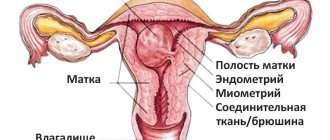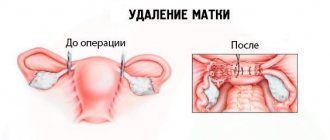The appearance of polyps in the uterus is accompanied by intense blood rejection during menstruation and discharge after intimacy. This pathology is caused by a lack of progesterone in the body and an excess of estrogen. Duphaston for endometrial polyp will come to the aid of nulliparous girls or women for whom surgery is contraindicated.
If polyps were surgically removed, this drug is often still prescribed after surgery. Its action in this case is aimed at preventing the appearance of tumors in the future.
Description and characteristics
Duphaston is a synthetic analogue of progesterone synthesized in a woman’s body. With the help of this medicine, you can not only get rid of polyps in the uterus, but also correct the hormonal balance that causes pathologies such as miscarriage, the threat of early miscarriage, infertility, and cure endometriosis. It is able to regulate the menstrual cycle if the absence of menstrual periods for several months is caused by hormonal imbalance.
If the polyp has a fibrous structure, then it needs to be removed only surgically. Treatment with Duphaston in this case will not give results. And if the neoplasm is glandular, then hormonal therapy will bring good results.
Therapy with this remedy is not always effective. The doctor prescribes it, taking into account the medical history of each individual woman.
Positive effect of the drug
Duphaston has a positive effect in the absence or disturbances of ovulation. Since it normalizes the duration of ovulation and promotes modulation of the phase of the cycle after it. When polyps form, a constant symptom is brown spotting. Taking this medicine stops them.
Unlike many drugs, this medicine does not provoke menstrual irregularities and its use does not suppress the reproductive function of the ovaries.
The drug is prescribed to pregnant women if there are difficulties in bearing a fetus. Namely, if there is a threat of miscarriage, bleeding in the early stages of pregnancy.
Additionally, Duphaston is prescribed after surgical operations to remove polyps, remove the uterus, for endometriosis, etc.
Advantages of the drug
Even if surgery can quickly get rid of a tumor, it is still an operation. If it is possible to avoid it, then it is better to do it with the help of Duphaston. This remedy has several advantages:
- Helps eliminate tumors in cases where surgery is contraindicated.
- It is often prescribed as therapy after surgical removal of an endometrial polyp. This is necessary in order to prevent new formations.
- The therapeutic result consists not only in combating abnormal tissue growths and preventing their occurrence, but also in preventing the threat of miscarriage in the early stages of pregnancy, as well as putting the menstrual cycle in order.
This medicine rarely causes side effects and has a beneficial effect on the body, which produces insufficient progesterone. Duphaston for uterine polyp is prescribed only by a doctor, and self-medication can lead to disastrous results.
Does Duphaston help?
Duphaston for a polyp in the uterus can be used as the basis of alternative drug therapy , without surgical intervention. The doctor makes this decision based on the patient’s reproductive plans or if there are serious contraindications to surgery (acute infections, pregnancy, uterine cancer).
Due to its unique structure, which most closely matches the natural female hormone progesterone , Duphaston helps stabilize hormonal levels and increases progesterone production when the cause of polyp formation is due to its lack. In general, the effectiveness of the drug in the treatment of uterine polyps is high, and Duphaston is often prescribed to prevent relapse of the pathology.
The doctor will be able to prescribe the drug Duphaston to the patient only after she has taken tests to determine the level of hormones in the blood.
The main indication for the drug is insufficient concentration of progesterone. Duphaston is also used for preventive purposes after removal of a polyp or instead of surgery. The dosage and duration of the therapeutic course are determined for each patient individually.
Prescribe medication for irregular cycles. To normalize it, the drug is indicated for nulliparous girls and women who are contraindicated for surgical removal of a tumor in the uterus.
Directions for use and dosage
This hormonal drug is prescribed to women for various pathologies associated with a lack of progesterone. The doctor outlines the treatment regimen individually in each specific case. On average, a single dose is 5–10 mg, daily – 10–30 mg.
For endometriosis or uterine hyperplasia, take Duphaston 1 tablet 2-3 times a day from the 5th to the 25th day of the cycle.
In the case of a combination of overly enlarged endometrium and uterine fibroids, 10 mg of the drug per day is prescribed, which should be divided into 2-3 doses.
If there is a threat of miscarriage in the early stages, then prescribe 1 tablet 2 times a day. The course of treatment continues until the 20th week, then the dosage is gradually reduced.
If signs of spontaneous abortion appear, the doctor recommends taking 4 tablets at a time. Then - one every 8 hours until the symptoms disappear. It is advisable to take Duphaston until the middle of pregnancy.
Only the treating gynecologist, who is aware of all the characteristics of a particular woman’s body, can prescribe such a serious hormonal drug.
With a polyp in the uterus
In some cases, Duphaston for a polyp in the uterus is used as a substitute for surgery. The doctor makes this decision in a situation where a woman is planning a pregnancy in the near future or surgical interventions are contraindicated for her.
If the formation of a polyp occurs due to a lack of progesterone in the female body, then the hormones of the drug, which are as close to natural as possible, will correct the hormonal imbalance. Therefore, there is a high probability that during treatment the growth inside the uterus will resolve.
Therapy with Duphaston is prescribed for the second half of the menstrual cycle. To combat tumors, it is taken in combination with other drugs. The action of such drugs is aimed at maintaining and restoring hormonal balance in the body. The course of treatment can last up to six months.
After polyp removal
After surgery to remove a benign tumor, hormonal drugs are prescribed in some cases. Duphaston is also included in postoperative therapy.
The course of treatment with Duphaston for endometrial polyps is prescribed by the attending physician. This takes into account:
- woman's age;
- complexion;
- desire to have children in the near future;
- degree of pathology damage;
- individual characteristics of the body.
The drug is prescribed for a period of 3 to 7 months. In order not to further disturb the ratio of hormones in the body, the medicine is not taken in the first phase of the menstrual cycle. Most often, gynecologists prescribe Duphaston from the 16th to 25th day of the cycle.
It must be remembered that this hormonal drug does not stimulate or suppress ovulation. Therefore, when taking it, you should not forget about contraception if pregnancy is not planned.
You also need to remember that it is not recommended to combine this drug with alcohol, as this reduces the effect of the drug and increases side effects.
Will Duphaston help with endometrial and uterine polyps: reviews from women
Duphaston therapy for a polyp in the uterus is of interest to many women who are faced with pathology. Some people are prescribed such treatment and it raises doubts, while others face surgery, so the search for a conservative method is urgent. Whether the use of the drug for endometrial polyps is effective, we will look into this article.
How are polyps of the uterus and cervical canal treated?
This pathology is the most common among diseases of the female reproductive system. It is more common in patients before menopause, but sometimes occurs in very young girls. The consequences of polyps can be chronic inflammation, bleeding, infertility and even uterine cancer, which is why it is so important to diagnose and get rid of the pathology in time.
In order to cure a disease associated with the appearance of a formation, you can go in 2 ways:
- Remove the growth surgically.
- Eliminate the causes of the pathology with medication.
The following are considered prerequisites:
- Hormonal imbalance with low progesterone levels;
- Obesity, which in itself creates the situation described above;
- Other endocrine disorders, including diabetes mellitus;
- Abortions, surgeries, difficult pregnancies and childbirths;
- Infectious inflammations.
It is not for nothing that the hormonal cause is in first place on this list, because it is one of the main factors that provoke the appearance of polyps.
The effectiveness of drug treatment
Conservative therapy is only in some cases capable of stopping growth, reducing the size, and sometimes causing the formation to resolve completely:
- If it is small. Hormonal drugs are prescribed for polyps up to 10 mm in length;
- A small amount, which is measured by the area affected by polyposis;
- Glandular and glandular-fibrous type of growth. Placental and fibrous polyps are resistant to drug treatment. Adenomatous ones are considered potentially the most dangerous, therefore, if detected, they are immediately removed. But in order to determine the type of formation, it is necessary to take material for histology; it is impossible to identify the type using ultrasound;
- If a blood test confirms an imbalance of the endocrine system.
Carefully! Choosing a medication on your own will do more harm than good.
This drug belongs to the group of gestagens, unlike combined contraceptives, it contains one active component - dydrogesterone. This is a synthetic analogue of the main female sex hormone - progesterone. Duphaston is popular because of its mild effect on the patient’s body. Side effects rarely occur during use:
- Swelling and pain in the mammary glands;
- Bloody spotting outside of menstruation;
- Rash on the body;
- Migraine attacks, dizziness;
- Increased gas formation.
Sometimes the use of Duphaston may be contraindicated:
- With uterine bleeding;
- Cancerous tumor;
- Severe damage to the liver and kidneys;
- During the period of breastfeeding;
- Under the age of 18;
- In case of individual intolerance;
- Porphyria.
For polyps, the drug is usually prescribed to women of the reproductive period from 25 to 40 years, as well as:
- Pregnant;
- Before menopause;
- For those for whom surgery is contraindicated;
- At an early stage of pathology;
- After hysteroscopy aimed at removing the formation in order to prevent relapse.
Interesting fact! Duphaston restores the stable functioning of the reproductive system, normalizes the cycle, promotes timely ovulation without inhibiting the functioning of the ovaries.
Usually the drug is prescribed from the moment the egg is released - this is the 16th day of the cycle for 10 days, 2 tablets. But everything is strictly individual. Sometimes the drug is used in combination with other medications, then their compatibility must be taken into account.
It is important to choose the right regimen for women planning a pregnancy after removal of a tumor, since with one option it is possible to conceive a child during treatment, but with the other it is not.
It is acceptable to choose the dosage yourself based on the instructions, but it is not a fact that it will be effective in the treatment of polyps.
If it is extremely difficult to remove the formation with the help of medications, then the use of Duphaston after removal of the polyp is an effective measure to prevent relapse.
For this purpose, after hysteroscopy, the drug is taken for about six months. This treatment is convenient for those who want a child. Unlike contraceptives, Duphaston, on the contrary, promotes the onset and maintenance of pregnancy.
Attention! After hysteroscopy, doctors advise waiting 3-4 cycles before conceiving until the uterus is completely restored.
The opinions of patients are divided, because for some the drug really helped them avoid surgery, while for others it turned out to be useless, and they had to remove the polyps using hysteroscopy. It is impossible to rely on other people’s experience in this matter, since with such formations treatment is always individual.
Gynecologists believe that it is necessary to take Duphaston if there are no acute indications for surgery. When there is an opportunity to get rid of a polyp without surgery, you need to take advantage of it. However, only hysteroscopy can reliably get rid of a uterine polyp.
The main thing is that Duphaston helps to normalize the functioning of the reproductive system, which will remove favorable circumstances for the reappearance of education. In the case of absolute contraindications to surgery or during pregnancy, only drug therapy can help the patient. As a result of use, bleeding is stopped and inflammation is eliminated.
Carefully! Doctors warn that self-medication with hormonal drugs sometimes leads to serious consequences. For example, it provokes tumor growth.
It is impossible to say whether Duphaston will help or not, but it is clear that this drug will restore normal functioning of the uterus and ovaries and help avoid the reappearance of polyps. It is possible to get rid of such a pathology 100% only through a set of measures, which includes drug therapy, removal and prevention.
Source: https://polips.ru/ginekologiya/dyufaston.html
Contraindications and side effects
Among the contraindications for taking Duphaston for uterine polyps are:
- Rotor disease;
- Dubin-Johnson syndrome;
- intolerance to any of the components included in the medicine;
- intermenstrual bleeding of unknown nature;
- hypersensitivity to the drug or allergy to it;
- acute or chronic liver diseases;
- lactation period;
- asthma;
- oncology;
- drinking alcoholic beverages. Combining alcohol and Duphaston increases the load on the liver and reduces the effect of the drug. There is also a serious effect on blood vessels, varicose veins and thrombophlebitis are possible.
- non-inflammatory kidney diseases;
- children under 18 years of age.
Side effects from using the drug are rare, but you still need to be aware of them:
- swelling of the mammary glands;
- yellowing of the skin;
- attacks of headache;
- frequent drowsiness;
- skin itching and burning;
- apathetic state, depression;
- bloody vaginal discharge not during menstruation;
- nausea and vomiting;
- bloating, flatulence;
- skin rash.
Unlike other hormonal drugs, Duphaston does not provoke menstrual irregularities and does not have a negative effect on the reproductive function of the ovaries.
If adverse reactions occur, you should consult your doctor. After all, in order to get rid of them, it is necessary to adjust the dose. And if an allergy begins, you need to stop taking the drug.
Features of treatment with duphaston for endometrial polyp
Duphaston therapy for a polyp in the uterus is of interest to many women who are faced with pathology. Some people are prescribed such treatment and it raises doubts, while others face surgery, so the search for a conservative method is urgent. Whether the use of the drug for endometrial polyps is effective, we will look into this article.
Duphaston for endometrial polyp: indications, regimen and dosage
Duphaston for polyps is prescribed as a gentle method of removing tumors.
The drug is prescribed depending on the type and structure of the polyp, age and characteristics of the woman’s menstrual cycle.
Independent use of hormonal-containing medications is unacceptable; it can lead to serious hormonal imbalance, the appearance of new tumors and other complications.
Composition and effect of the drug
Duphaston refers to hormone-containing drugs based on a synthetic analogue of progesterone. The hormone is synthesized in the body of every woman and plays a special role in the reproductive system.
The drug is intended not only for the removal of polyps, but also for:
- Stabilization of hormonal levels,
- Infertility treatment,
- Preservation of pregnancy,
- Treatment of tumors and endometriosis.
The beneficial effect on the body is achieved due to the composition of the drug:
- dydrogesterone - the main component (10 mg in 1 tablet);
- polyethylene glycol;
- magnesium stearate;
- corn starch;
- colloidal silicon dioxide;
- lactose monohydrate;
- titanium dioxide
Auxiliary components enhance and stabilize the activity of progesterone. The drug is sold from pharmacy chains without a prescription in the form of tablets.
Impact principle
Regular use of the drug Duphaston normalizes the balance of progesterone along with estrogen.
A hormone-containing drug has the following therapeutic effects on the female body::
- Tissue differentiation, expulsion of neoplasms;
- Prevention of spontaneous abortion, miscarriages with risks of endometrial detachment;
- Relaxation of the smooth muscles of the uterus;
- Stimulation of growth of the uterine cavity;
- Normalization of the menstrual cycle;
- Preparing the endometrium for better attachment of a fertilized egg.
Duphaston is prescribed to prevent the growth of polyps, restore the structure of the endometrium after the removal of various tumors, and abortions.
Indications
Duphaston is prescribed after appropriate diagnosis. If the cause of the endometrial polyp is progesterone deficiency, then the use of the drug is advisable.
There are other indications for use:
- infertility, problems with conception;
- uterine endometriosis;
- complicated beginning of pregnancy, risk of miscarriage;
- menstrual irregularities, including secondary amenorrhea;
- painful premenstrual syndrome;
- intrauterine bleeding;
- surgical intervention on the internal genital organs.
The appointment is carried out only by the attending physician.
Contraindications and side effects
The basis for the prescription is a reduced level of progesterone and the pathologies accompanying this condition. An absolute contraindication is individual intolerance to the active substance or additional components.
The drug is prescribed with caution for the following diseases and conditions:
- endocrine disorders (diabetes, thyroid dysfunction);
- epilepsy, convulsive syndrome;
- liver and kidney failure;
- acute pathologies of the genitourinary system;
- heart failure, including previous acute conditions.
Side effects
Despite the insignificant list of contraindications, the drug Duphaston is prescribed to patients strictly according to indications due to the risk of developing negative consequences:
- From the liver structures : nagging pain, icteric syndrome, malaise and weakness;
- Circulatory system, blood : the development of hemolytic anemia is likely, which is provoked by a sharp decrease in red blood cell mass;
- Reproductive organs : uterine bleeding, hypersensitivity of the mammary glands;
- Allergic reactions : typical rashes such as urticaria, itching, minor swelling, severe allergies such as Quincke's edema and anaphylactic shock are rare;
- Nervous system : paroxysmal migraines, headaches.
In general, the drug is well tolerated. In case of overdose and side effects, the drug is discontinued and symptomatic therapy is prescribed. In many cases, after discontinuation of the drug or dose adjustment, adverse reactions go away on their own.
Application regimen and dosage
The tablets are drunk whole, without chewing, with plenty of water. Violation of integrity leads to ineffectiveness of the drug. The dose and regimen of use vary greatly and depend on the woman’s condition, goals of therapy, and gynecological history.
There are several basic recommendations for taking the drug:
- Endometriosis . Reception begins from 5 to 25 days of the cycle continuously, the duration is set individually.
- Risk of miscarriage . The maximum first dose is 40-50 mg, after which another 10-15 mg is taken every 8 hours until the risks are relieved. Afterwards the drug is taken 1 time per day.
- Several miscarriages in a row . The drug is taken 2-3 tablets per day for 20 weeks until the condition stabilizes. The dosage is gradually reduced and the drug is discontinued.
- Infertility . If problems with conception are caused by insufficiency of the corpus luteum of the ovaries, then the drug is taken from the 14th to the 25th day of the cycle, 1 tablet once a day. The course of treatment is 6-10 cycles of administration.
- Painful premenstrual syndrome . Prescribed from days 5 to 25 of the cycle, 1-2 tablets per day.
- Uterine bleeding . 1 tablet 2-3 times a day until bleeding stops. Afterwards the dose is reduced.
When used along with other hormones, Duphaston is recommended to be taken from the 14th day of the menstrual cycle. Estrogens are started taking 1 tablet for the next 14 days. When cyclically using several hormonal drugs at once, it is recommended to keep a special calendar compiled by a gynecologist.
With a polyp in the uterus
Duphaston for uterine polyps is taken in the second phase of the menstrual cycle. A different scenario leads to even greater hormonal imbalance. The course of therapy is 3-6 months.
Drug treatment of endometrial polyps is carried out along with other medications. Medicine knows of cases where, after taking Duphaston, a polyp disappeared.
How to take Duphaston after polyp removal?
Prescribing Duphaston tablets after hysteroscopy of an endometrial polyp or surgical intervention is the most common clinical situation. Hormonal medications after surgery not only improve the condition of the internal genital organs, but also prevent relapses. More recommendations in the postoperative period after hysteroscopy of the uterus with polyp removal are here.
The course and regimen of treatment depends on multiple factors (age, desire for pregnancy, stage of damage to mucous structures, complexion, and others). The average duration of treatment is 5-7 months with control ultrasound at least 2 times a year. They start drinking Duphaston from the 14th to 25th day of the cycle phase.
Cost of the drug
The average cost ranges from 400 to 700 rubles per pack of tablets. The final price depends on the region, the level of pharmacy chains, and suppliers of pharmacy products.
In addition, a specialist talks about the effect of low progesterone on the female body and the use of Duphaston:
Source: https://congress-ott.ru/zdorove/osobennosti-lecheniya-dyufastonom-pri-polipe-endometriya.html
Preventive actions
To prevent the appearance of not only polyps, but also any other gynecological neoplasms, and also to prevent the growth of already existing pathologies, you need to:
- for the purpose of prevention, visit a gynecologist at least once a year;
- timely correct hormonal imbalances in the body;
- if any abnormalities in the reproductive system are detected, make an appointment with a gynecologist;
- take careful precautions without planning pregnancy;
- use a condom when having sexual intercourse with a non-regular partner;
- eliminate defects in the vagina and cervix formed after childbirth;
- If acyclic bleeding occurs, consult a doctor immediately.
If a woman has already been diagnosed with polyps, she should immediately begin treatment, which the doctor considers most appropriate. If you take Duphaston after removal of an endometrial polyp, you must then systematically visit a gynecologist and listen sensitively to your body.











